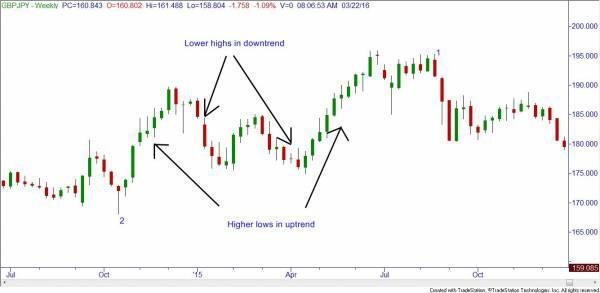Hello traders! This week’s newsletter will give you a bit of insight into the power of candlestick charts, especially when applied to your largest timeframes. Let’s get started on how to read candlestick charts and when to use them!
First of all, candlestick charts show us four pieces of information, they are:
-
The open (or first) trade of the time frame you are looking at
-
The high – highest priced trade for that timeframe
-
The low – the lowest priced trade for that timeframe
-
The close (or last) trade of the timeframe you are looking at. If the candle body is green, the bottom of the body is the open and the top of the body is the close; if the candle body is red, the open is the top of the body and the close is the bottom of the body. The “wicks”, “shadows”, or “tails” show how the highs and lows are placed in relationship to the open and close.
There are numerous Lessons From the Pros articles written about the basics of how to read candlestick charts. If you are new to them please dig a little and then come back to this piece.
At Online Trading Academy we believe that you should be looking at several timeframes to formulate your plan for any individual trade. This week, I’m going to focus on using weekly candlestick charts to help us get an idea of what will happen over the following few days of the next week. Generally, I want to know what the weekly charts are doing because it gives me a HUGE hint on what the big institutions are doing with their trades/positions. I’m not too concerned with 5 minute candles; when you start looking at small timeframes like 5 minutes, you end up trading too often (at least I do). Personally, I would rather ride the coattails of long term institutions than sit at my trading screen for most of the day!
There is an old phrase in trading: “Amateurs control the open and pros control the close.” Hey, it even rhymes! What I want to see is the CLOSE of a candle very near the highs, or a close very near the lows. I also prefer the candle itself to be larger than the previous candle. Notice the red candle marked “1”. Its high was higher than the previous green candle’s high, and the low was lower – hence a bigger candle. See where the red candle closed? Almost at the very bottom of its entire range. Also, it closed lower than the previous two candles’ lows. This is a small hint that there is an imbalance building in our supply and demand equation, probably to the downside. Here is the lesson: a very low (or very high) close relative to the range of the candle very often points us in the direction of the FIRST HALF of the next candle. Said another way, when a weekly candle closes at/near the very low, the first few days of the next week will more than likely go lower as well.
Now notice the red candle marked “2”. Many new traders will say that any red candle is bearish, but they would be incorrect. This particular candle is actually very bullish. As stated before, each candle shows the open, close, high and low. Notice the close vs. the low; that was a very strong move to the upside! As far as I’m concerned, there just wasn’t enough time in the week to close higher than the open, which would have given us a green candle. Notice how even the next candle (green) closed near its high, which leads us to believe the next candle will go in the same direction. Also, the very large next green candle closed near its high, leading us to believe the next candle would at least start off in the same direction.
Another helpful hint with these larger timeframe candles is to look at the lows of the candles in uptrends and the highs in downtrends. In both uptrends marked, the weekly candle lows had higher lows for several weeks at a time. Now, I’m not saying you would have bought the bottoms and sold the tops, but the first trend lasted from about 168.00 all the way to 189.50, and the second uptrend went from 175.00 to about 195.50. Not bad if you can pull out a chunk of those moves by paying attention to the weekly candle hints! In downtrends, pay attention to the candle highs. As long as the highs are still lower, this would lead you to believe that the downtrend is still intact. The two downtrends marked went from 187.80 to 175.70 and 185.00 to 175.00.
Obviously, no trend lasts forever. As the students of Online Trading Academy and the long time readers of these Lessons know, an uptrend will usually end at a significant supply zone and a downtrend will usually end at a significant demand zone. My hope is that by using these two candlestick charting hints, you will be able to pull out more pips when your chosen market is trending!
Until next time.
This content is intended to provide educational information only. This information should not be construed as individual or customized legal, tax, financial or investment services. As each individual's situation is unique, a qualified professional should be consulted before making legal, tax, financial and investment decisions. The educational information provided in this article does not comprise any course or a part of any course that may be used as an educational credit for any certification purpose and will not prepare any User to be accredited for any licenses in any industry and will not prepare any User to get a job. Reproduced by permission from OTAcademy.com click here for Terms of Use: https://www.otacademy.com/about/terms
Editors’ Picks

EUR/USD struggles for direction amid USD gains
EUR/USD is trimming part of its earlier gains, coming under some mild downside pressure near 1.1730 as the US Dollar edges higher. Markets are still digesting the Fed’s latest rate decision, while also looking ahead to more commentary from Fed officials in the sessions ahead.

GBP/USD drops to daily lows near 1.3360
Disappointing UK data weighed on the Sterling towards the end of the week, triggering a pullback in GBP/USD to fresh daily lows near 1.3360. Looking ahead, the next key event across the Channel is the BoE meeting on December 18.

Gold losses momentum, challenges $4,300
Gold now gives away some gains and disputes the key $4,300 zone per troy ounce following earlier multi-week highs. The move is being driven by expectations that the Fed will deliver further rate cuts next year, with the yellow metal climbing despite a firmer Greenback and rising US Treasury yields across the board.

Litecoin Price Forecast: LTC struggles to extend gains, bullish bets at risk
Litecoin (LTC) price steadies above $80 at press time on Friday, following a reversal from the $87 resistance level on Wednesday. Derivatives data suggests a bullish positional buildup while the LTC futures Open Interest declines, flashing a long squeeze risk.

Big week ends with big doubts
The S&P 500 continued to push higher yesterday as the US 2-year yield wavered around the 3.50% mark following a Federal Reserve (Fed) rate cut earlier this week that was ultimately perceived as not that hawkish after all. The cut is especially boosting the non-tech pockets of the market.
RECOMMENDED LESSONS
Making money in forex is easy if you know how the bankers trade!
I’m often mystified in my educational forex articles why so many traders struggle to make consistent money out of forex trading. The answer has more to do with what they don’t know than what they do know. After working in investment banks for 20 years many of which were as a Chief trader its second knowledge how to extract cash out of the market.
5 Forex News Events You Need To Know
In the fast moving world of currency markets where huge moves can seemingly come from nowhere, it is extremely important for new traders to learn about the various economic indicators and forex news events and releases that shape the markets. Indeed, quickly getting a handle on which data to look out for, what it means, and how to trade it can see new traders quickly become far more profitable and sets up the road to long term success.
Top 10 Chart Patterns Every Trader Should Know
Chart patterns are one of the most effective trading tools for a trader. They are pure price-action, and form on the basis of underlying buying and selling pressure. Chart patterns have a proven track-record, and traders use them to identify continuation or reversal signals, to open positions and identify price targets.
7 Ways to Avoid Forex Scams
The forex industry is recently seeing more and more scams. Here are 7 ways to avoid losing your money in such scams: Forex scams are becoming frequent. Michael Greenberg reports on luxurious expenses, including a submarine bought from the money taken from forex traders. Here’s another report of a forex fraud. So, how can we avoid falling in such forex scams?
What Are the 10 Fatal Mistakes Traders Make
Trading is exciting. Trading is hard. Trading is extremely hard. Some say that it takes more than 10,000 hours to master. Others believe that trading is the way to quick riches. They might be both wrong. What is important to know that no matter how experienced you are, mistakes will be part of the trading process.
The challenge: Timing the market and trader psychology
Successful trading often comes down to timing – entering and exiting trades at the right moments. Yet timing the market is notoriously difficult, largely because human psychology can derail even the best plans. Two powerful emotions in particular – fear and greed – tend to drive trading decisions off course.


